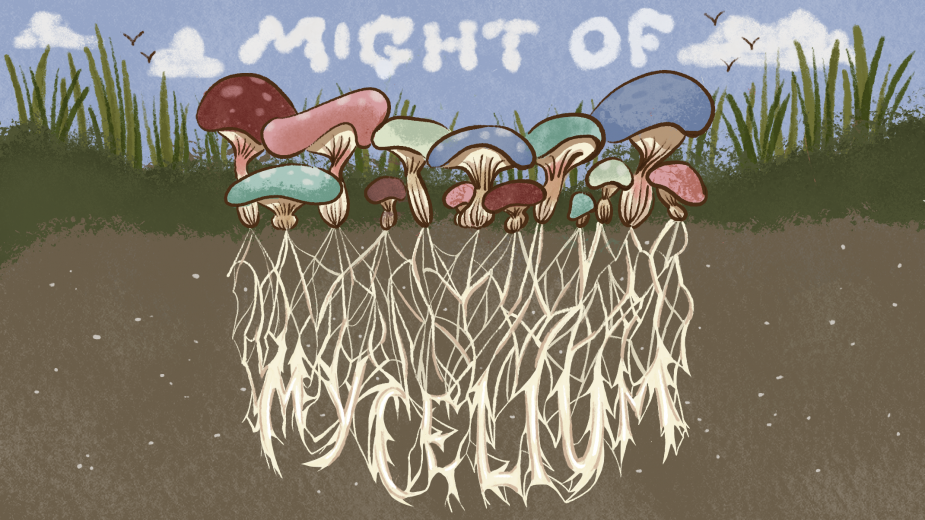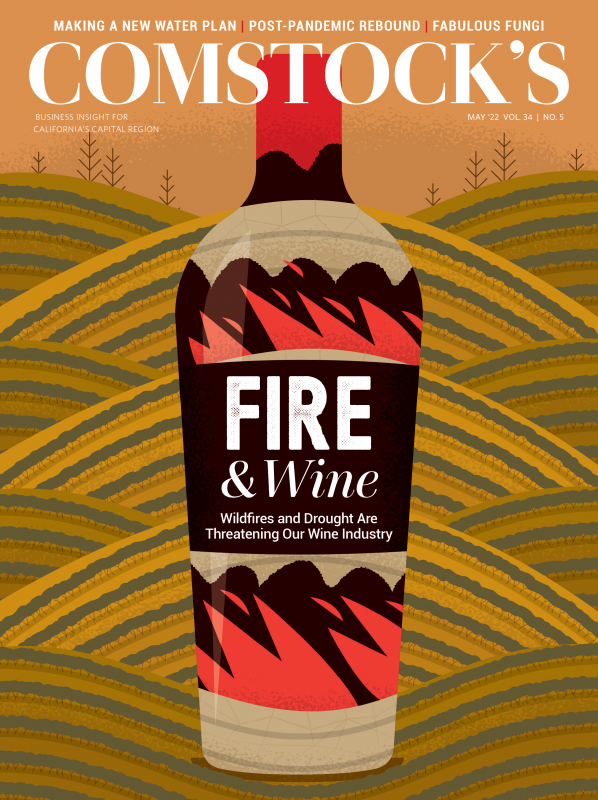The goddess Fermentia looms over The Better Meat Co.’s production facility in West Sacramento. In a digital painting that hangs above the entrance to the fermentation room, she resembles a shieldmaiden from Norse mythology — though dressed in a lab coat and sensible shoes. A supplication is printed below her sneakered feet: “Oh Fermentia, please protect us from contamination and bad data.”
“We offer her many sacrifices to keep her content,” says Paul Shapiro, CEO of The Better Meat Co., pointing out the $100 bills arrayed on a shrine-like shelf beneath the painting. It’s an unusual sight for a food production facility, but typical for the accelerating field of mycelium technology, where science is often tinged with fungi fanaticism.
A digital painting of Fermentia, a personification of
fermentation, hangs in the laboratory of The Better Meat Co.
(Photo by Jennifer Fergesen)
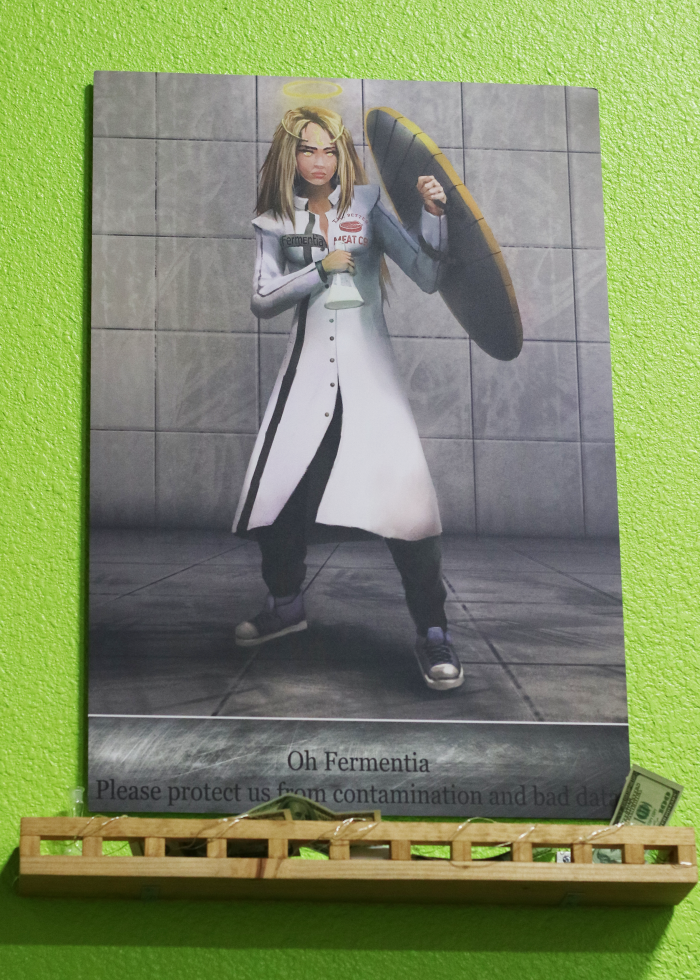
Mycelium, meanwhile, is ubiquitous. It wends below forests, clings to specks of dust and forms white tussocks under the lids of forgotten yogurt tubs. It can grow to staggering sizes: The largest known organism in the world is a fungus living in northeast Oregon’s Malheur National Forest, and its mycelium spans an area of 3.5 square miles, penetrating trees and transporting nutrients through its network. Over 700 million years after fungi first evolved, this rapidly renewable resource is finally being tapped by companies looking for solutions to environmental and societal issues.
The Better Meat Co. makes its mycelium product into meat
substitutes such as this vegan bacon. (Photo by Jennifer
Fergesen)

A blank slate
Mycelium grows as fine filaments called hyphae that draw nutrients and chemicals from their environment. When enough hyphae grow together in one place, such as in a mold or in a fermenting vat at a production facility, the result is a grayish-white mass with a fibrous structure. It’s a blank slate of a material — vegan, biodegradable and plastic-free. Companies are developing mycelial packaging, textiles, shoes, paper and even bricks for biodegradable homes. The Better Meat Co. is one of a handful making mycelial meat.
A substance that can stand in for Styrofoam or polyester may not sound like something one would want to eat. But The Better Meat Co.’s mycelium — a proprietary species that the company calls Rhiza mycoprotein — looks edible even in its pure state. It has a soft, fibrous texture like chicken breast and a mildly savory flavor that recalls mushrooms, though it belongs to one of the many fungi species that don’t produce them.
The writer holds a piece of The Better Meat Co.’s dried,
unflavored mycelium. (Photo by Jennifer Fergesen)
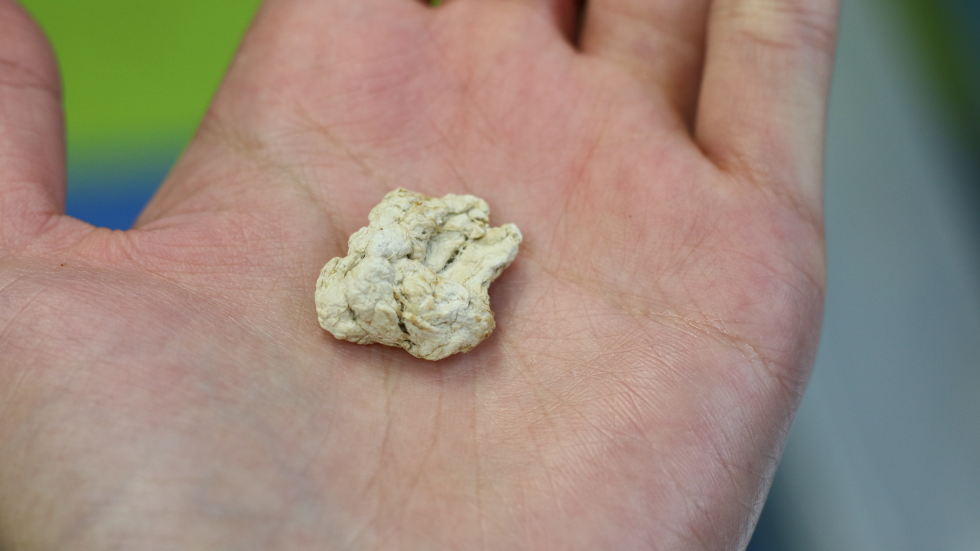
At the West Sacramento research and development facility, the company has made the product into vegan sausages, bacon and even a meatless steak with a realistically red core, like medium-rare New York strip. A full house of invited guests tried the mycelium steak at Bennett’s American Cooking on Fair Oaks Boulevard in Sacramento last year. However, shoppers won’t find The Better Meat Co.’s brand name on any products at the supermarket. It’s a business-to-business company that sells its products to other food producers (primarily Hormel Foods, which entered an exclusive partnership with the company last year).
Before people can eat the Rhiza mycoprotein, the Rhiza mycoprotein must eat. Its feedstock is mostly agricultural waste such as the inedible parts of potato and corn plants. The fungi ferments the feedstock for less than one day before it’s ready to be harvested. The process looks similar to the fermentation that happens at breweries, but brewers are after the product of fermentation — ethanol — rather than the fungus itself. Shapiro compares his version of fermentation to raising chickens for meat, rather than for eggs.
An antique whale harpoon hangs on the wall of The Better Meat Co.
facility. (Photo by Jennifer Fergesen)
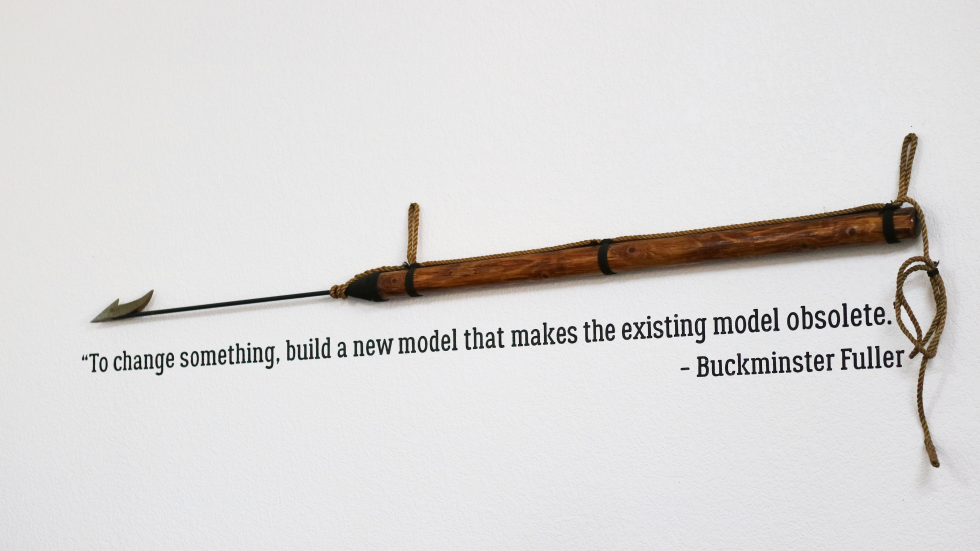
A whale harpoon hangs near the entrance of the facility as a prop for the CEO’s favorite metaphor about his company’s mission. Whales were once slaughtered for their oil, which was a major source of light and heat for centuries. The rise of petroleum products (specifically kerosene) led to the decline of the whaling industry; by the time the Save the Whales movement came around in the 1970s, it had already all but died out. So some believe it was the rise of a preferable product, not marches and sit-ins, that really saved the whales. With mycelium, Shapiro hopes to create the kerosene of meat.
When people switch on their lamps today, they’re not thinking about if the energy came from fossil fuels, solar energy or whale oil; they just want light. “Similarly, when most people eat meat, they’re not thinking, ‘I’m so glad that an animal was slaughtered,’” Shapiro says. “They’re just thinking, ‘I like the taste of this. I like the experience of eating this piece of meat.’ And that’s what we want to replicate: that experience where you can enjoy all the meat that you want, without the need to harm animals and destroy the planet in the process.”
Associate chef Jared Goldstein crafts avocado toast with
mycoprotein bacon and sausage while food technician Danica Tan
works on product formulations in the test kitchen at Better Meat
Co. in West Sacramento. (Photo by Fred Greaves)
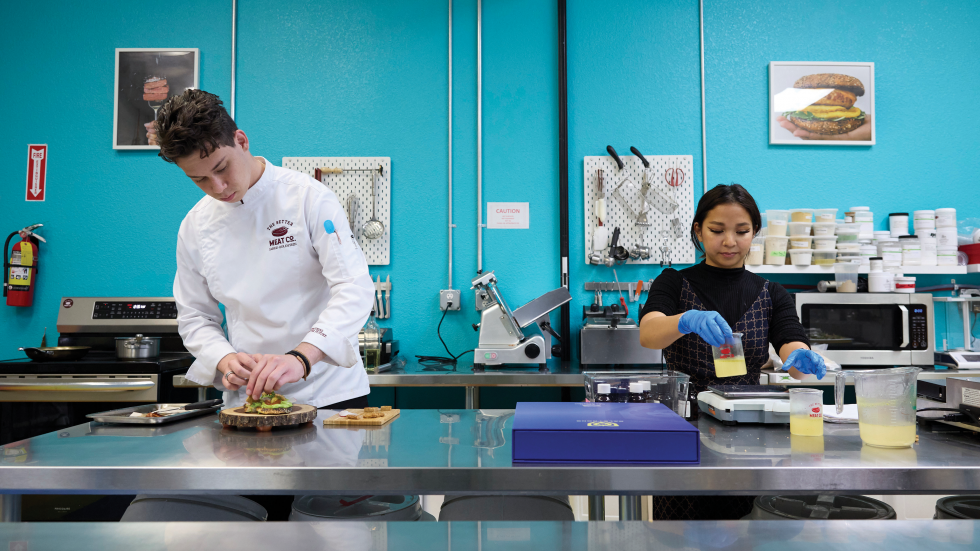
‘An untapped material’
A few miles away from West Sacramento at UC Davis, a team of engineers, scientists and designers is researching ways to apply mycelium to other human problems. It all started, says Professor Valeria La Saponara, with children’s heads.
La Saponara teaches in the university’s mechanical and aerospace engineering department and specializes in fiber-reinforced polymer composites. In 2016, she and her business partner Rachael Fulp-Cooke co-founded a startup devoted to building better-fitting bicycle helmets for children. As the startup’s sole engineer, she made simplified bike helmet shapes out of mix-and-pour polyurethane foam, then subjected them to impact testing until they broke and she had to make some more. Eventually she got tired of the polyurethane’s toxic-smelling fumes and began searching for a natural alternative.
That search led her to Ecovative, a New York-based company that has patented processes for growing pure mycelium materials (AirMycelium) and composites of mycelium and agricultural and forestry byproducts (MycoComposite). To make MycoComposite, workers inoculate the biomass with fungi, and the mycelium binds them together as it feeds. A blast of heat kills the fungi after five to seven days of growth in a mold. Ecovative licenses this technology to companies around the world. One of its licensees is Paradise Packaging, a growth and distribution hub for Ecovative’s Mushroom Packaging that opened in 2019 to help the town of Paradise recover after the previous year’s devastating Camp Fire.
La Saponara purchased Ecovative’s consumer grow-it-yourself kits and began experimenting with the composite material to replace the foam liner of the helmets. Her startup folded in 2019, before she could implement her ideas. “Good timing; a lot of startups got destroyed in any case by the pandemic,” she says.
Valeria La Saponara holds growing mycelium composite samples for
structural applications. (Photo courtesy of Valeria La Saponara)

Since then, she has convened a motley crew of UC Davis faculty and students around mycelium and its possibilities. The main players are Nitin Nitin, professor of food science and biological and agricultural engineering; Ameer Taha, associate professor of food science and technology; and Katia Vega, assistant professor of design and head of the Interactive Organisms Lab. With help from a $20,000 seed grant from The Green Initiative Fund at UC Davis, the professors are exploring various applications for mycelial structures, like hyphae branching in different directions while continuing to work as a unit. (They will become official collaborators when they apply for U.S. Department of Agriculture funding.)
Vega has previous experience working with mycelial materials. In 2019, she and graduate student Eldy Lázaro Vásquez built circuit boards using Ecovative kits and published findings on their efficacy at a London conference. She’s now working with La Saponara to prototype stronger mycelial circuit boards that work well enough to cut down on plastic waste in the university’s computer labs.
La Saponara is growing multilayered composite structures from mycelium and plywood that look like tuna sandwiches in cross-section. She says stress tests show the composite materials are remarkably strong despite their light weight. They may have potential for use in wind turbine blades, which are currently made of complex composite materials that are neither biodegradable nor recyclable.
Research engineers Alex Weinstein and Shuhao Wan, Ph.D. student
Shree Nagarkar and UC Davis Graduate Studies summer research
scholar Aidelen Montoya of CSU San Marcos prepare
mycelium/bamboo/biomass samples in summer 2022. (Photo courtesy
of Valeria La Saponara)
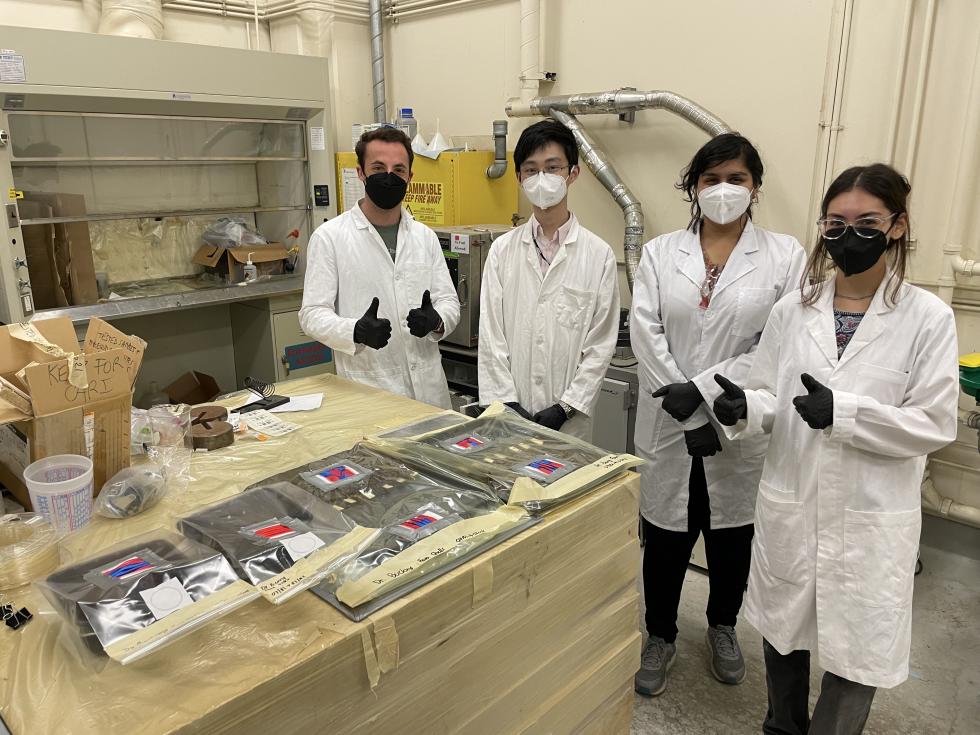
Taha shares intellectual property with La Saponara on a project focused on mycoremediation, the practice of removing toxins from an environment with fungi, with help from biologist Vanessa Salandez. Nitin is collaborating on this project, and he and graduate student Yixing Lu are also testing mycelium’s ability to take up useful molecules such as flavoring compounds, medicine, or supplements like curcumin and other flavonoids. Mycelium containing these molecules may be sold as food or health products in the future.
Hyphae, grasping and voracious, have evolved to draw up all manner of molecules as they search for food. In some cases, hyphae can absorb harmful chemicals, allowing the fungi to metabolize them into more benign forms; in others, the fungi can draw materials (such as heavy metals) into its tissue and keep them there. The professors are analyzing how mycelium may be able to draw antibiotic residues from water, especially runoff from farms that feed antibiotics to animals. Antibiotics currently appear in water supplies around the world in trace amounts, and some cannot be removed by conventional water treatment plants.
Initial results are promising, and the team will soon run a pilot project at the UC Davis Student Farm. La Saponara considers the mycoremediation project the mycelium team’s most important initiative. “If we can keep people healthier by making sure antibiotics are removed from the water supply, that’s something that has immediate repercussions,” she says.
A silver bullet?
In the shadow of California’s recent megafires, a group of “radical mycologists” have already put the cleansing powers of mycelium to the test. Soon after the CZU and LNU lightning complex fires died out in 2020, members of the nonprofit CoRenewal gathered at burn sites in their wake. Dressed in rainboots and respirators, the volunteers spread straw wattles — those burlap-wrapped snakes used for erosion control — in areas where ash from burned residential areas might leach into streams.
CoRenewal volunteers place mycelium spores in straw wattles
around burn sites in California. (Photo courtesy of Taylor
Bright)

Every few feet, the volunteers stabbed knives into the burlap and sprinkled in dust from mason jars. The jars contained mycelium from Pleurotus ostreatus, the familiar oyster mushroom. Robust and readily available, Pleurotus’ appetite stands out even among its omnivorous kingdom. It has been shown to happily decompose diapers, disposable masks, polyurethane and diesel-polluted soil, in all cases still producing edible mushrooms. It can also draw up heavy metals from its environment, though the mushrooms in these cases may be too contaminated to eat safely.
CoRenewal aims to use mycelium to remove toxins from water
supplies, such as the chemicals from burned residential areas
that can leach into water after fires. (Photo courtesy of Taylor
Bright)

“With how amazing and magical fungi are, I think it’s really easy to get what I call mycocentric, and think that fungi are this silver bullet solution for everything on the planet.”
Taylor Bright, mycologist
“With how amazing and magical fungi are, I think it’s really easy to get what I call mycocentric, and think that fungi are this silver bullet solution for everything on the planet,” she says. “It’s like, fungi can break down our petroleum toxins, fungi can sequester heavy metals, fungi can eat plastic, so we can just go about as normal and then fungi will clean up all of our problems.” She says fungi should be seen as just one tool in an arsenal of biological and holistic solutions to environmental issues.
“They’re a really, really powerful ally, but there also needs to be some real, systemic change in the way that we walk through the world as a society, as a collective,” she says. “That’s what the fungi are trying to tell us.”
–
Stay up to date on business in the Capital Region: Subscribe to the Comstock’s newsletter today.
Recommended For You
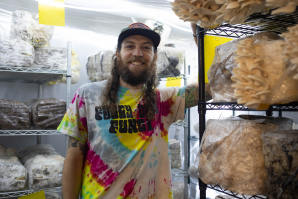
Fascinating Fungi
Foggy Dew Fungi brings gourmet mushrooms to the Capital Region
Foggy Dew Fungi is a small, family-operated gourmet mushroom farm deep in the hills of Newcastle in Placer County, built on respect for nature and strong community ties.
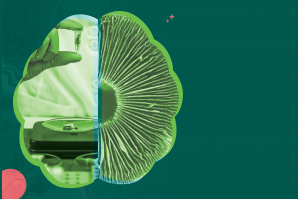
Harnessing Psychedelics for Healing
A UC Davis chemist is developing drugs with all the therapeutic effects of psychedelic drugs — without the hallucinogenic trip.
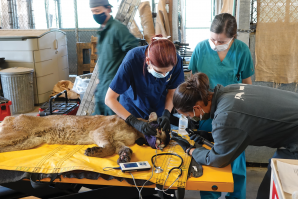
Saving Our Wildlife
When raging wildfires engulf our forests, what happens to the animals?
Capital Region researchers, veterinarians and advocates are
finding innovative ways to rehabilitate wildlife burned by
California’s raging wildfires.
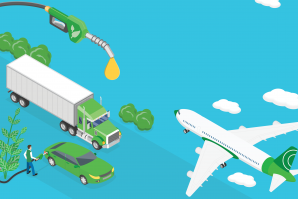
Out of the Woods
Could biomass technology help reduce megafires and build a wood-products market in California?
The process of turning wood waste into fuel not only
represents a breakthrough in the biofuels industry, but also
helps to create more resilient forests that can better
withstand wildfire.



